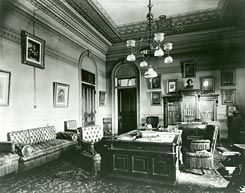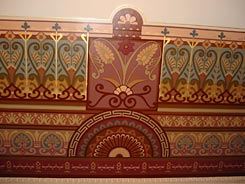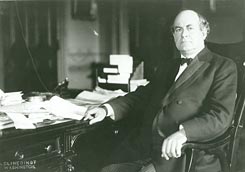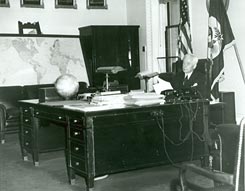- African-American History Month
- Presidents & Baseball
- Grounds and Garden
- Easter Egg Roll
- Christmas & Holidays
- State of the Union
|
Home >
History & Tours >
Eisenhower Executive Office Building
|

The Cordell Hull Conference Room - Room 208
Former Secretary of State's Office
|
When the south wing for the State Department first opened in 1875, it had three spectacular rooms designed to be showplaces for the department. One of these was the office of the Secretary of State located at the center of the second floor with three windows opening onto the south portico and a view of the Potomac River. The other two rooms included the State Department Library (now the EOP Library) and the Diplomatic Reception Room (rooms 212 and 214).
The Secretary of State's office contains extensive areas of painted ornament, described in a contemporary issue of Harper's new Monthly Magazine as "Egyptian figures in gray chocolate and gilt, traced upon a pearl ground." 1 The abstract stenciled patterns were, in fact, more Greek than Egyptian in derivation, but were exquisitely painted and gilded and were complemented by the furniture, draperies, and Oriental rugs originally chosen for the room. Also displayed in the room from 1875 to the early 1940s was the Great Seal of the United States of America.
A total of 24 men served 25 terms as Secretary of State (James G. Blaine served as Secretary of State for two terms - the first term March 7, 1881 to Dec. 19, 1881, and the second term March 7, 1889 to June 4, 1892). Hamilton Fish was the first Secretary of State to serve in this office beginning July 14, 1875 until March 12, 1877. He and his staff moved into the building before the wing was fully completed in December 1875. Around 1940, all of the stenciled ornament was painted over, and the decorative furniture removed, but a massive mahogany fireplace mantel, beautifully carved with Doric columns flanking a stylized lion's head survived as a reminder of the former richness of the office. The room was restored in 1987 by uncovering layers of paint over the original stenciled patterns to confirm their design, and then replicating them on canvas, which was applied to the walls and ceiling. Today, it is used as a conference room, and named "The Cordell Hull Conference Room" after the Secretary of State who signed the most treaties within the building.
Events to Occur in Room 208Many important events have occurred in this room. For example, here in 1898, Secretary of State John Hay handed the Spanish ambassador his credentials and passport, thus signifying our declaration of war against Spain. During his term, Hay supported an American imperialist solution to the Spanish-American War, helped formulate the "Open Door" policy in China, arranged treaties to facilitate the building of the Panama Canal, and worked with President Roosevelt in settling the Russo-Japanese War. Secretary of State William Jennings Bryan resigned on June 8, 1915 in a disagreement over the United State's handling of the sinking of the Lusitania, which was sunk on May 7, 1915 by Germany.Secretary of State Robert Lansing presided over the department as the US tried to remain neutral to all that was occurring in Europe. Despite repeated warnings to Germany to halt their sub warfare aiming to sink neutral ships that enter the war zone, they sunk several ships. Germany's sinking of the United States' liner Housatonic off the coast of Sicily on February 3, 1917 was the final straw, and the US severed diplomatic relations with Germany. Secretary of State Lansing personally handed Count Von Bernstorff his passports in this office. Twenty-four years later some other diplomats were also dismissed from this office. On Sunday morning, December 7, 1941, Secretary of State Cordell Hull was in his office in the Old State Building, now the EEOB, meeting with his aides and discussing the volatile situation in the Far East. The meeting was interrupted when intercepted messages between Japanese Prime Minister Togo and the Japanese Ambassadors to the US were delivered to Secretary Hull's office.The message from Togo relayed the negative Japanese response to the peace proposals put forward by the US on November 26th. The intercepted message went on to instruct Ambassadors Nomura and Kurusu to inform Secretary Hull of the Japanese position on the peace proposals that afternoon at precisely 1:00 pm, Washington time. In due course, Ambassador Nomura called the Secretary and requested a 1:00 pm meeting. The Ambassador phoned later to request a postponement to 1:45 pm. Ambassadors Nomura and Kurusu finally arrived shortly after 2:00 pm, and were asked to wait in the Diplomatic Reception Room. Within moments of their arrival in the building, Secretary Hull received a phone call from President Roosevelt who described an unconfirmed report that at 1:00 pm, Washington time, the Japanese had attacked the US naval fleet stationed at Pearl Harbor, Hawaii. In his memoirs, Secretary Hull described the meeting with Ambassadors Nomura and Kurusu that followed the President's call: "Normura and Kurusu came into my office at 2:20 pm. I received them coldly and did not ask them to sit down. Japan officially declared war on the US later that evening. Congress declared war on Japan the next day, December 8, 1941. It was in his speech to Congress that afternoon that President Roosevelt first described "a date which will live in infamy." Later, in 1942, the United Nations Declaration was drafted and signed in this room. George Catlett Marshall was the last Secretary of State to serve in this office. Marshall oversaw the move of the Department of State staff from the EEOB to their new offices in Foggy Bottom, in the old War Department building, which was mostly complete by May 1947. |







